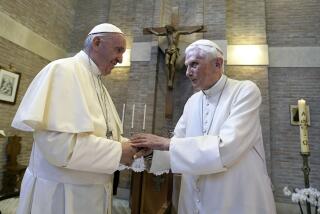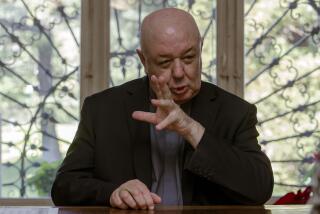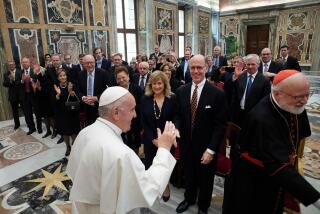Book review: ‘Absolute Monarchs’
Absolute Monarchs
A History of the Papacy
John Julius Norwich
Random House: 513 pp., $30
When preeminent British historian John Julius Norwich tells us in the introduction to his sweeping history of the Catholic papacy that his job is to give us “a straightforward single-volume history” of the world’s “most astonishing social, political, and spiritual institution ever created,” he’s hit the nail on the proverbial head. The centuries-old Roman papacy truly is a universally unrivaled institution, and in dense detail, Norwich’s book shows us the historic playbook.
As Norwich says upfront, “Absolute Monarchs” is a political history more than anything, and with his unstuffy and sometimes witty writing style, he walks us through what could otherwise be a stifling couple of thousand years of popes, antipopes, endless political power struggles, war, greed, torture, inquisitions, egomania, incest, fornication, bastard children and orgies. . Reading page after page of this cacophony of temporal sin, one begins to wonder whether this is a history of a religious institution at all.
For, most assuredly, these figures on the whole are portrayed not as solemn men of sober duty but rather as worldly leaders of a vastly powerful and wealthy global institution that, writes Norwich, today counts “two billion members, representing as it does half of all Christians and about one-sixth of the global population.” For Catholics and non-Catholics alike, this is surely an extraordinary feat, one, he suggests, that is built upon a short passage in the Gospels, Christ’s pronouncement to St. Peter: “Thou art Peter, and upon this rock I will build my church.”
From this humble and not entirely historically accurate beginning, Norwich writes, have sprung hundreds of popes such as Leo the Great, who protected Rome from the Huns and the Goths; Leo III, the first pope to place an imperial crown on the head of a king (Charlemagne); and all the other vicars of Christ who have struggled with emperor after emperor for supremacy. There’s also a chapter devoted to Joan, a mythical pope who, legend has it, ruled in the guise of a man from about 855 to 857, and who was said to have given birth on the street during a procession from St. Peter’s Basilica.
Thankfully, these fighting men in their red hats are not without interest: take Celestine V, an 85-year-old hermit, who in 1294 became the first pope to abdicate. The architect of the abdication, Cardinal Benedetto Caetani, was said to have placed a secret speaking tube in Celestine’s cell through which, in the small hours of the night, “he would simulate the voice of God, warning him of the flames of Hell if he were to continue in office,” Norwich writes.
You’ll also need a nimble mind while reading this volume, as you may be confused by the curious habit of naming hundreds of popes through 2,000 years from a handful of names, mostly John, Paul, Gregory, Leo, Pius, Benedict and Innocent. It’s a European history stuffed with the seemingly same swirling cast of characters: French, Spanish, English and Italian monarchs from whom each newly elected pope must re-wrench control. I took notes.
And although it’s the “monstrous” and hypocritical high Renaissance popes, shameless in their ribald greeds and sexual escapades, whom many people remember from history class (especially Alexander VI — now played by Jeremy Irons in Showtime’s television series “The Borgias”; Julius II; and the Medici Leo X), it’s the 19th and 20th century pontiffs whose doctrines, such as the assumption of Mary, the infallibility of the pope and the Immaculate Conception, transformed the Catholic Church into what we know today. It was, in fact, Pope Pius X who, during World War I, lowered the age of First Communion to 7.
Of course, there’s still soreness today over Pope Pius XII’s anti-Semitism and contemptible silence during the Holocaust, and his successors, John XXIII and John Paul II, who shook the world by opening the church’s doors to the modern age. Pope John Paul I, who died a mere month after his election in 1978, had one of the shortest reigns in papal history and was followed by John Paul II, the modern phenomenon whose 26 years was the papacy’s second-longest reign. Current Pope Benedict XVI is facing a world-wide Catholic clergy sex-abuse scandal that also marked the late papacy of John Paul II.
As “Absolute Monarchs” is mostly free of the author’s opinion and commentary, we are left to ourselves to ponder what this scandalous history of the church’s history means. Why, for example, would a global body built on the shoulders of a Galilean Jew who steadfastly denounced worldly power, violence and greed and whose main commandments were to love thy enemies and take not the important seat for yourself conduct itself with such utter opposing hypocrisy? One hopes the next 2,000 years of papal history may answer that question.
Kinosian is a freelance writer and critic.
More to Read
The biggest entertainment stories
Get our big stories about Hollywood, film, television, music, arts, culture and more right in your inbox as soon as they publish.
You may occasionally receive promotional content from the Los Angeles Times.






